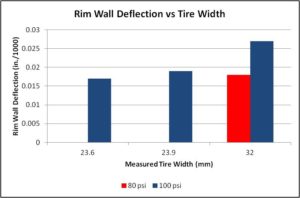I was working on a post about shift cable fatigue and fraying when I became distracted by a Lennard Zinn Technical FAQ discussion in Velonews about tire width and rim stress. As an engineer I know that a wide tire imposes higher forces on a rim, specifically lateral force on the sidewalls, than a narrow tire – at any given pressure.
I found the various explanations put forth by Lennard and some of his readers confusing, so I drafted a response invoking the hoop stress formula, etc. But I decided that instead of another explanation I would perform and video a visual demonstration of rim deflection as tires of different widths are pressured up to 100 psi.
Wide tire proponents will argue that running a wider tire allows use of lower pressure. OK, I agree. I am demonstrating that, all else equal, the wider the tire, the more rim stress. (I did take one set of measurements to determine how much pressure reduction would be required in a 32mm tire to induce stress equal to 100 psi in a narrower tire, like a 23mm or 25mm; keep reading).
Oh, by the way, I’m talking about clincher tires and rims. And I am addressing the forces on the rim, not the forces in the tire casing – though I maintain that the forces in the tire casing also get higher as tire size increases.
Anyway, as you pressure up a tire, the tire drives the rim walls away from each other. The rim gets a tiny bit wider. So I rigged up a test apparatus with my Park Tools wheel truing stand and a dial indicator. I measured rim deflections as I pressured up 23mm, 25mm, and 32mm tires to 100 psi, each on the same wheel. It turns out that the change in width is quite measurable, on the order of up to .030” (thirty thousandths of an inch).
In a video that is sure to be nominated for academy awards in several categories, I documented my work and posted it on Killa’s Garage YouTube. If you don’t want to watch a really cool five minute video, complete with the sound of my compressor kicking on while pressuring up the 32mm tire, here is a table of key results.
| Rim |
Rolf Prima Vigor |
||
| Tire | 23mm Conti 4000 S ii | 25mm GatorHardshell | 32mm Specialized All-Condition |
| Tire Actual Width at 100 psi | 23.6mm | 23.9mm (This surprised me) | 32.0mm |
| Rim Deflection at 100 psi* | .017” | .019” | .027” |
| Rim Deflection at 80 psi* | Not recorded | Not recorded | .018” |
*Deflection values are rough averages of several pressure cycles. But I was gratified to observe that even with my primitive apparatus, values for each set of conditions varied no more than +/-.001”.
If these deflection values seem high, keep a few things in mind:
- The rim I used is a fairly lightweight racing rim. I tried this with a heavy (thick-walled) inexpensive rim from a cheap hybrid and got less than .010” sidewall deflection with the 32mm tire at 100 psi.
- My methodology measured the total deflection of both sidewalls. In other words I measured the total rim width change.
- This is the deflection at the outer edge of the rim.
- The deflection returned to zero when the pressure was removed, showing that the elastic limit of the rim was never exceeded.
- This is why you need to pay attention to the minimum thickness marks on the braking surface of your rims.
Here is a bar chart of my results … for people who prefer bar charts.
And a summary of results … for people who prefer summaries.
The measured width of my 23mm and 25mm tires are very similar, as are the induced rim deflections. The 32mm tire is much wider and it induces a much higher rim deflection at the same pressure. However, if you can run your 32mm tire at 80 psi you induce deflections similar to the narrower tires at 100 psi.
I can see utility in doing some further testing. I could evaluate different rims. I’d like to see how a full carbon rim responds. But I’ll leave that for another time.
Now if I can come up with a device to fatigue test shift cables I can answer the question I was working on when I got distracted by tire width and rim stress.
Thanks for reading
Killa
